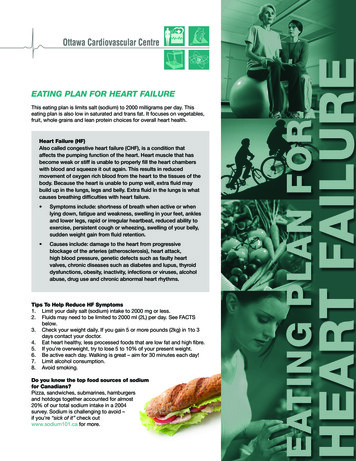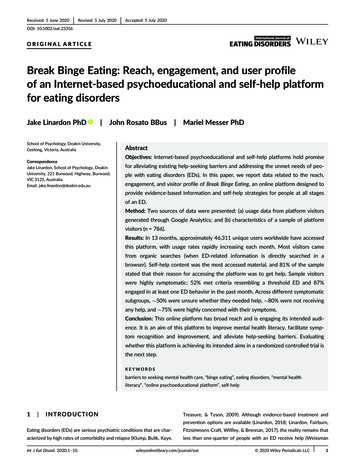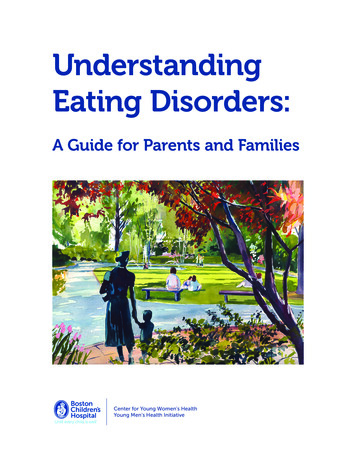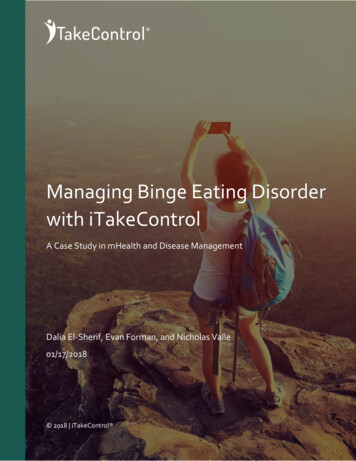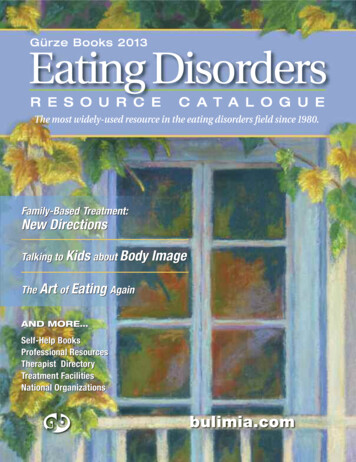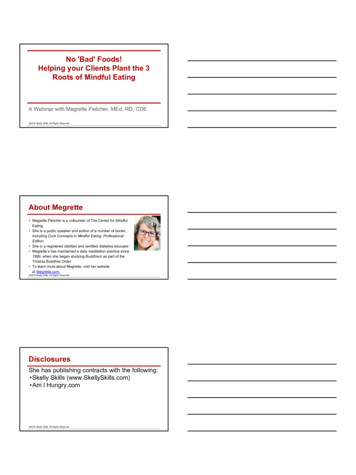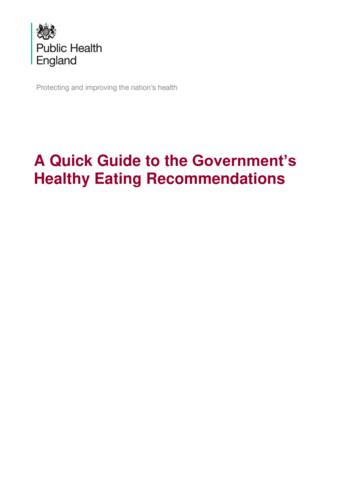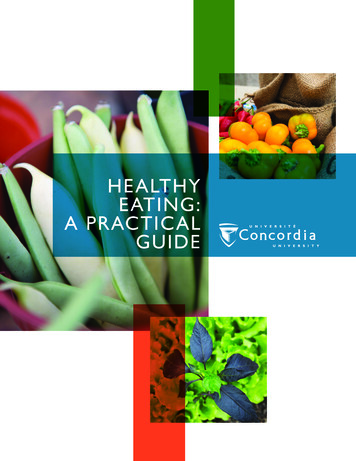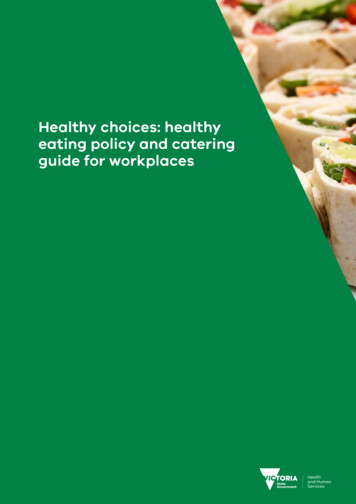
Transcription
Healthy choices: healthyeating policy and cateringguide for workplaces
Healthy choices: healthyeating policy and cateringguide for workplaces2016i
AcknowledgmentsThe Healthy choices: healthy eating policy and catering guide for workplaces is adaptedfrom the Queensland Department of Health’s A better choice: healthy food and drink supplystrategy for Queensland health facilities (2007) and the Victorian Department of Education andTraining’s School canteens and other school food services policy (2012).The Victorian School canteens and other school food services policy (2012) was based on theNSW Department of Health and NSW Department of Education and Training’s Fresh Tastes @School NSW Healthy School Canteen Strategy (2004).ContactFor more information about the Healthy choices: healthy eating policy and catering guide forworkplaces contact healthychoices@dhhs.vic.gov.au.To receive this publication in an accessible format phone 9096 9000 using theNational Relay Service 13 36 77 if required, or email healthychoices@dhhs.vic.gov.auAuthorised and published by the Victorian Government, 1 Treasury Place, Melbourne. State of Victoria, Department of Health and Human Services, December 2016Except where otherwise indicated, the images in this publication show models and illustrativesettings only, and do not necessarily depict actual services, facilities or recipients of services.Where the term ‘Aboriginal’ is used it refers to both Aboriginal and Torres Strait Islander people.Indigenous is retained when it is part of the title of a report, program or quotation.ISBN 978-0-7311-7057-9Available at www.health.vic.gov.au/nutrition (1604006)
Contents1. Introduction ivWhy create a healthier workplace? 1Benefits of a healthier workplace 1The Healthy Choices framework 2Who is this resource for? 22. Five steps to implementation 6Five steps for implementation 7The traffic light classification system 73. Healthy eating policy template 144. Healthy catering guide 20Using the Healthy catering guide 21The traffic light classification system 21Appendix 1. Useful resources and websites 30Appendix 2: Sample action plan 31
1IntroductionivHealthy choices: healthy eating policy and catering guide for workplaces
Why create a healthierworkplace?Benefits of a healthierworkplaceWith diet overtaking smoking as the leading cause1of early death and ill health , workplaces are idealsettings for encouraging healthy eating as manyworkers consume at least half their daily meals andsnacks during work hours.For employers, the benefits of promoting health andwellbeing in the workplace are wide-ranging andinclude:Promoting healthy eating in the workplace cancontribute to: better physical and mental health reducing the risk of chronic disease (studies have2shown a four to 10 per cent reduction in heartdisease risk for every additional serve of fruit orvegetable consumed each day) obtaining adequate vitamins and minerals byeating a wide variety of foods each day andboosting immunity by eating the recommendeddaily amounts of vegetables reduced absenteeism – successful health andwellbeing initiatives can reduce sick leaveabsenteeism by an average of 25.3 per cent3 reduced turnover – organisations that do notsupport health and wellbeing are four times morelikely to lose employees4 becoming an ‘employer of choice’ increased workforce innovation and creativity.For employees, the benefits of promoting health andwellbeing can include: improved health and wellbeing increased productivity improved morale reduced stress and anxiety.1 Institute of Health Metrics and Evaluation (IHME) 2013, ‘Globalburden of disease (GBD)’, viewed 10 June 2015, www.healthdata.org/results/data-visualizations .Australian Bureau of Statistics (ABS) 2012, Causes of death,Australia, 2010, Cat. no. 3303.0, ABS, Canberra.2 Dauchet L, Amouyel P, Hercberg S, Dallongeville J 2006, ‘Fruit andvegetable consumption and risk of coronary heart disease: ameta-analysis of cohort studies’, Journal of Nutrition, vol. 136, no.10, pp. 2588–2593.3 Workplace Health Association of Australia WHAA (2015)Best-Practice Guidelines; Workplace Health in Australia.4 World Economic Forum in partnership with Right Management(2010), The Wellness Imperative: creating more effectiveorganisations, World Economic Forum, Geneva.1
(5%) and high blood pressure (5%). It is important toreinforce the need for greater access to healthy foodsand drinks in our community.5The Healthy ChoicesframeworkGood nutrition is important for a healthy lifestyleand contributes to health and wellbeing. Togetherwith physical activity, healthy eating plays a keyrole in preventing disease, promoting wellbeingand productivity, maintaining a healthy weight andpromoting better oral health.One-third of the burden of disease can be prevented.An analysis of the combined effects of thirteen dietaryrisk factors (such as, high sodium and sweetenedbeverage intake and low fruit, vegetable and fibreintake) found that they make up 7% of preventabledisease burden. Other risk factors that caused highdisease burden were tobacco use (9%), high bodymass (5.5%), alcohol use (5%), physical inactivityThe Victorian Government is putting health atthe centre of our everyday lives through a placebased systems approach to prevention and healthpromotion. This involves increasing access to healthyfoods and drinks in the places where people spendtheir time.Healthy Choices is a framework for improvingavailability and promotion of healthier foods anddrinks in workplaces and community settings(Figure 1).Using the Healthy Choices framework, workplaces canprovide consistent health promoting messages so thatthe foods and drinks available align with the values oforganisations that support good health.Figure 1: The Healthy Choices frameworkHealthy choices:food and drinkclassification guideHealthychoices: policyguidelines forhospitals andhealth servicesHealthy choices:policy guidelinesfor sport andrecreationcentresClassificationguideHealthy choices:healthy eatingpolicy andcatering guide forworkplacesHealthy choices:policy guidelinesfor parksPolicyguidelinesDownload resources from www.health.vic.gov.au/nutrition DownloadsFor implementation support contact theHealthy Eating Advisory Service www.heas.health.vic.gov.au Contact forsupport5 Australian Institute of Health and Welfare, Australian Burdenof Disease Study: impact and case of illness and death inAustralia 2011, available from www.aihw.gov.au/publicationdetail/?id 60129555173 2Healthy choices: healthy eating policy and catering guide for workplaces
Who is this resource for?The Healthy choices: healthy eating policy andcatering guide for workplaces is for organisationswanting to provide healthier food and drinks foremployees and visitors.Organisations are encouraged to use the Healthyeating policy template (Section 3) and Healthycatering guide (Section 4) as part of a broaderapproach to workplace health and wellbeing.Workplaces registered with the Achievement Programcan use this resource to work towards meeting therequirements of the healthy eating benchmarks.The Healthy choices: healthy eating policy andcatering guidelines for workplaces includes thefollowing three parts:1Implementation process– five steps to assistwith introducing the policy and catering guidein your workplace2Healthy eating policy template – a ready-touse policy template that can be adapted toyour workplace needs3Healthy catering guide – clear and practicalguidance for choosing healthier options whenpurchasing food and drinksThe Achievement Program makes it easier forVictorians to be healthy. It achieves this throughimproving the health of places where adults andchildren spend their time – in workplaces, schoolsand early childhood services.It allows workplaces, schools and early childhoodservices to broadly take a look at health andwellbeing within their organisation to determinewhat policies, cultural and environmental changesare needed to meet best practice benchmarksacross a number of health priority areas includinghealthy eating.Implementing the Healthy Choices policysupports the achievement of the healthyeating benchmarks as part of creating healthyworkplaces, schools and early childhoodservices. For more information visit www.achievementprogram.health.vic.gov.au Note: Throughout this document, the term ‘catering’ isused broadly to refer to any food and drinks providedor paid for by the workplace for employees andvisitors.3
An example of marketing resources available for retail food outlets meeting the Healthy Choicesguidelines4Healthy choices: healthy eating policy and catering guide for workplaces
5
2Five steps toimplementation6Healthy choices: healthy eating policy and catering guide for workplaces
Five steps forimplementationThe traffic lightclassification systemThis section outlines a five step process (Figure 2,below) to help you implement a healthy eating policyin your workplace, using the Healthy eating policytemplate (Section 3) and Healthy catering guide(Section 4).Workplaces can use the Healthy catering guide(Section 4) to select healthy food and drinks foremployees. The guide classifies food and drinksas GREEN, AMBER or RED based on the trafficlight system in the Healthy choices: food and drinkclassification guide.Each step includes a checklist of recommended tasksfor all workplaces, and ‘extra’ tasks for workplacesthat offer food and drinks from multiple locations (forexample, a kitchen, staffroom, vending machine orcatering for meetings).Reading the Healthy catering guide and becomingfamiliar with the principles of classifying food anddrinks as GREEN, AMBER or RED is recommendedprior to starting.For workplaces participating in the AchievementProgram, these five steps align with the steps forprogressing through the Achievement Program cycle.The Healthy eating policy template and Healthycatering guide can be adapted to your organisation’sworkplace and staff requirements.Figure 2: Five steps for implementing a healthyeating policy in the workplaceGettingstartedAssessingthe currentsituationPlanningfor changePutting theplan intoactionMonitoringandmaintainingmomentum7
GREEN – best choice, to be available at all times andpromoted and encouraged when food and drinks areprovided by the workplaceFoods and drinks in the GREEN category are thehealthiest choices. They are usually: good sources of important nutrients lower in saturated fat, added sugar and/or salt lower in energy (kilojoules) higher in fibre.GREEN foods and drinks are based on the five foodgroups in the Australian guide to healthy eating.Examples of GREEN food and drinks are: sandwicheson multigrain and wholemeal breads; wholegraincereals; fresh and frozen fruit and vegetables;reduced- or low-fat milk and yoghurt; vegetablefrittatas; lean meat; roast chicken salads; fresh andfrozen fish; eggs; and plain, unsalted nuts and seeds.AMBER – choose carefully and avoid large servesAMBER foods and drinks should be selected carefullyand consumed in moderation. Although AMBER itemsmay provide some valuable nutrients they can:chicken, fish or vegetable products. Order smallerserves where possible (such as mini muffins).RED – avoid this category of food and drinksFoods and drinks in the RED category are basedon ‘discretionary choices’ in the Australian dietaryguidelines. These items are not essential in abalanced diet and can contribute to excess energyintake, overweight and obesity and chronic disease ifconsumed frequently or in large amounts. In generalRED choices are: high in energy (kilojoules) high in saturated fat, added sugar and/or salt lacking in important nutrients such as fibre.RED food and drinks are not to be supplied throughcatering, and no more than 20 per cent of items invending machines should be RED. Request reducedfat, reduced-sugar and reduced-salt options.Examples of RED food and drinks are confectionery,pastries, cakes, biscuits, all sugary drinks (such assoft drinks, cordials, energy drinks and sports drinks),deep fried foods, potato chips, pies, sausage rolls andprocessed meats such as salami. contribute to excess energy (kilojoule) intake contain moderate amounts of saturated fat, addedsugar and/or salt.Look for healthier choices among food and drinks inthis category. For instance, provide plain un-iced fruitbuns instead of iced buns or provide plain scones(with the jam and margarine served separately).Examples of AMBER food and drinks include full fatmilk and yoghurt, some flavoured milk and dairydesserts, some processed meats such as ham andcorned beef in small amounts, and some crumbed8The Healthy Eating Advisory Service supportsorganisations wanting to put Healthy Choicesinto practice. The Service provides informationand advice, training and a comprehensivewebsite with online learning and menuassessment tools, fact sheets, and recipes tohelp with providing healthier foods and drinksacross the organisation. For more informationvisit www.heas.health.vic.gov.au. Healthy choices: healthy eating policy and catering guide for workplaces
Step 1. Getting startedPlanning and preparation is the first important step when making healthy changes.Use the examples in the table below as you work through the ‘Getting started’ step.Recommended tasksDate completedSeek management endorsement and ongoing support for implementing a healthyeating policy. Strong management leadership and support will assist you to implementthe policy and maintain any changes to current practice.Nominate a staff member, establish a new committee or use an existing committee tohelp plan and manage the healthy changes which will be occurring.Inform employees of the organisation’s plans for making healthy changes and identifyopportunities for staff to provide feedback on the policy and the catering guide.Involving staff in a meaningful way is important for achieving success and ongoingsupport for healthy changes in the workplace.Examples: Suggestion box, email address, focus groups, surveys, team meetings, staffemails, notices in staffrooms, newslettersStart an action plan for implementing your healthy eating policy (the action plan willbe added to in the next four steps). Once your action plan is complete, review andupdate your drafted healthy eating policy to ensure that it includes all commitmentsyour organisation has made regarding healthy eating.See Appendix 2 for a sample action plan.In your action plan, identify how you will accommodate Aboriginal perspectives andthe needs of staff, volunteers, members and visitors of different cultural and linguisticbackgrounds. Additionally, consider how you will accommodate older people and thosewith special needs.ExtraDate completedIf establishing or using an existing committee, aim to include representatives from allparts of your workplace, including management. This allows the views and ideas ofdifferent stakeholders, and will help you share responsibilities of policy implementationacross the organisations.If a committee is not formed, establish a strategy for including different areas withinthe workplace in policy development and implementation.As the policy is being implemented, identify one or more workplace coordinators topromote the healthy changes being made and to encourage staff to make healthierfood and drink choices.9
Step 2. Assessing the current situationBefore making any changes you will need to determine what is currently happening across the organisation andidentify areas for improvement. The table below includes ideas to help you assess the current situation.Recommended tasksDate completedIdentify current catering or food related policies (for example, workplace health andwellbeing policies, breastfeeding support strategies, procurement policies), and note inyour action plan if these require updating.Note key workplace personnel (such as staff responsible for organising catering orbuying supplies) in your action plan. These people will be instrumental in supportingthe new healthy eating policy and catering guide.In your action plan, list the situations where foods and drinks are available, and thetypes of foods and drinks that are provided in each situation. For example: kitchens, staff rooms – fruit box, biscuits, coffee, tea, milk, water cooler vending machines – soft drink, water, snacks on-site retail outlets (for example, a café) – sandwiches, muffins catering for meetings, functions and events – sandwiches, pastries alcohol – at the end of year Christmas celebration and Board meetings fundraising, gifts and prizes – chocolate boxes, wine bottles.Check whether drinkable water is freely available for employeesUse the Recommended Options in the Healthy catering guide (Section 4) to categorisethe foods and drinks as GREEN, AMBER or RED.Examples: Pastries ordered for morning tea are RED; the fruit box in the staffroom isGREEN.Record the categorised food and drinks in your action plan. This will assist you withprioritising action areas (under step 3).Determine whether there are facilities for employees to store and prepare healthy foodand drinks brought into the workplace. Record this in your action planExamples: Refrigerator, microwave, cutlery and crockery, food storage cupboardsExtraDate completedLarger workplaces may wish to allocate different committee members to lead changein specific areas of the organisation.If your organisation has tender and lease documents and contracts with food anddrink suppliers (for example, retailers, vending machine suppliers and caterers), reviewthem and see whether these documents include requirements for providing andencouraging healthy foods and drinks.If your organisation would like an event to be outside the scope of this policy, forexample Christmas functions , note these in your action plan and Healthy eating policyIdentify if resources, information and opportunities are provided to increaseknowledge and skills for healthy eating, for example. where food and drink is providedon-site.Identify how your organisation engages with the wider community to support healthyeating and healthy food initiatives, for example supporting local school or communityvegetable gardens or social enterprise healthy catering schemes.10Healthy choices: healthy eating policy and catering guide for workplaces
Step 3. Planning for changeOnce you have an idea of what the current situation is and the issues that need to be addressed, you can make aplan which outlines the steps that need to be taken to make healthy changes.Recommended tasksDate completedDecide on priority locations where healthy changes are needed. Think about ‘easywins’ that can be carried out early on as well as changes that require more time andplanning.Examples: Setting up a chilled water tap or water cooler in your staff kitchen, or adedicated space for staff to take meal breaks away from their desks.Where food and drinks are provided, determine the changes required to increaseGREEN options and reduce RED options.Examples: Order fruit bread for morning tea instead of pastries; support fundraisingopportunities not related to food and drinks, such as plant drives.Note: The Healthy catering guide provides a comprehensive list of healthieralternatives to common food and drinks.Identify supporters of healthy change.Examples: greater staff interest and awareness of health, meeting needs of staffwanting healthier options, embedding a healthy eating culture in your workplace.Identify barriers to change and ways to overcome these. Document these in youraction planExamples: Cost of catering, contracts with caterers, staff resistance to change,difficulty accessing GREEN products, lack of demand for healthy products, low priorityfor staff, concern over loss in profits, unsuitable facilities to prepare healthy food anddrinks, extra time needed for staff to plan for and make changes.Document the timing of planned changes in your action plan. The timing of healthychanges which may depend on current stock levels and availability of healthieroptions from suppliers.If using external caterers, develop a list of preferred food and drink suppliers and localcaterers who are able to provide healthier choices.Update (or replace) current catering or food policies (including relevant workplacehealth and wellbeing and procurement policies) in line with your new healthy eatingpolicy.ExtraDate completedWhere food and drink is provided on-site by the organisation, develop point of salepromotion strategies to encourage purchase of healthier options.Encourage onsite cafeterias with contractual or lease arrangements to follow ahealthy food service policy and provide healthy food and drinks consistent with theHealthy choices: food and drink classification guide.11
Step 4. Putting the plan into actionOnce you have a plan for making healthy changes, it’s time to put the plan into action, starting with the priorityareas identified.Changes don’t need to happen all at once. A staged approach is useful for making positive changes over time andto ensure new initiatives are well accepted and maintained.Recommended tasksDate completedRefer to the action plan developed in steps 1–3. Starting with priority areas, carryout the tasks, actions and strategies you have identified. Ensure that managementcontinues to support and communicate healthy changes across the organisation.Communicate healthy changes to staff.Examples: Email, newsletters, team meetings, posters in staffrooms/kitchens.Remember to also communicate why, how and when changes are happening.Identify additional information, resources and opportunities across the workplaceto motivate and inform staff about healthy food and drink choices, in places such asdisplay boards, intranet, reception, tea rooms and cafeterias.Examples: Posters, healthy eating leaflets, competitions between teams, sharing healthyrecipes, education sessions, healthy lunch or cooking demonstrations. See Usefulresources and web sites (Appendix 1) for links to promotional material and fact sheets.Ensure healthier food and drink choices are easy and appealing.Example: Several companies offer delivery of fresh fruit and vegetable boxes. Theseare a great alternative to biscuits in the staffroom.Ensure all available food storage facilities, preparation spaces and food preparationequipment is easily accessible and maintained to high food safety standards. For moreinformation about food safety refer to www.health.vic.gov.au/foodsafety/ Examples: A fridge, sandwich maker, toaster, microwave, cutlery and crockery canmake it easier for staff to bring healthy lunches to work.Communicate healthy changes to caterers and suppliers, if applicable.Examples: Provide suppliers with a copy of your organisations healthy eating policyand Healthy catering guide.Organise a healthy morning tea or lunch for staff to promote healthy changes in theorganisationNote new barriers or emerging issues and solutions in the action plan.Include operational issues that may need to be addressed to help increase healthierfoods and drinks and phase out unhealthy optionsExample: Work with your existing caterer to see if they can offer healthier choices orchange your caterer/supplier to one that is able to provide healthier options accordingto the Healthy catering guide.ExtraDate completedSet up a catering panel or preferred caterer list of suppliers that are able to providehealthier food and drink options. If you already have a panel or preferred suppliers,provide them with a copy of the Healthy catering guide and advise them of your newhealthy eating policy.If your workplace is preparing food for its employees, rather than ordering fromcaterers, refer to the Recommended Options tables in the Healthy catering guide(Section 4) or Healthy Choices: food and drink classification guide.12Healthy choices: healthy eating policy and catering guide for workplaces
Step 5. Monitoring and maintaining momentumOnce healthy changes have been made, it is important to monitor your progress by undertaking regular reviews.Continue to reflect on your progress, communicate with stakeholders and seek and incorporate feedback asrequired.This will help you maintain motivation, and will also help you determine further actions and initiatives that may berequired.Recommended tasksDate completedContinue to monitor progress, identifying improvements or additional changes thatmay be required as you go.Regularly review your action plan while implementing changes, and then continue toreview the plan every 12 months to ensure relevance.Seek ongoing feedback from staff about the changes that have already been madeas well as any changes planned for the future. Caterers and suppliers may also haveuseful feedback.Highlight successful changes in newsletters, via social media or at team meetings.Provide ongoing opportunities for staff to increase their healthy eating knowledge andskills.Examples: Cooking classes or ‘making a healthy lunch’ classes (either provided by theworkplace directly or as a staff reward).Encourage staff to actively participate in promoting healthier choicesCelebrate success!Example: Put on a healthy lunch for all staff to enjoy.Extra considerationsDate completedOffer rewards or incentives for staff participation. Acknowledge caterers that havemade an extra effort to provide healthier options.Examples: Workplace recognition, for example via the Achievement Program, waterbottles, health books, gift vouchers.Invite new people to join the implementation committee. New members often bringcreative ideas, skills and enthusiasm and may identify issues that have not previouslybeen noted.13
3Healthy eatingpolicy template14Healthy choices: healthy eating policy and catering guide for workplaces
A Word version of this template that you can adapt to suit your organisation, is available from the Healthy EatingAdvisory Service website at onal-policy-template . This policy is adapted from WorkSafe Victoria’s WorkHealth Healthyeating policy (2010).Healthy eating policy for [insert organisation’s name]Purpose[Insert organisation’s name] recognises and values the importance of healthy eating in promoting people’s healthand wellbeing. [Insert organisation’s name] is committed to creating a health promoting environment whichsupports employees and visitors to make healthy food and drink choices.AimThis policy aims to support and encourage healthy eating in the workplace. Through this policy [insertorganisation’s name] will ensure healthy food and drinks are available at meetings, functions and events andthrough onsite retail outlets, vending machines and organisational fundraising.ObjectivesThe objectives of this policy are to support: employees and visitors to make healthy food and drink choices by:– creating a healthy eating culture and environment which supports healthy food and drink choices– increasing availability and promotion of healthier foods and drinks– decreasing availability and promotion of unhealthy foods and drinks– increasing employee knowledge and skills of employees regarding healthy eating [insert organisation’s name] to meet the healthy eating benchmarks of the Achievement Program (applicable toorganisations participating in the Achievement Program).Where does this policy apply?This policy applies in all areas where foods and drinks are sold or provided to employees and visitors.This includes [include the following as relevant to your organisation]: food and drink retail outlets such as restaurants cafeterias, cafes, canteens, kiosks (including mobile food kiosks)and coffee carts other retail outlets that mainly sell foods and drinks (such as convenience stores) vending machines catering provided for meetings, functions and events (such as workshops, conferences, community events,launches, celebrations and ceremonies) and client or community education or training programs catering provided by external user groups fundraising activities rewards, incentives, gifts, prizes and giveaways advertising, promotion and sponsorship.The policy does not apply to food and drinks brought from home by employees (for example, birthdays, morningteas or personal fundraising). However, employees are encouraged to consider providing healthy options at alltimes and to avoid promoting unhealthy fundraising activities (such as chocolate or confectionery drives) in publicplaces, such as kitchens.15
ProcedureTable 1 outlines the requirements that [insert organisation’s name’] will undertake to support and encourage healtheating.[Note: insert requirements your organisation has identified via the implementation steps and action plan)Table 1: Requirements for supporting healthy eating at [insert organisation’s name’]Food and drink choicesArea (include as required)RequirementsCatering (meetings, functions,events) Majority GREEN choicesAdvertising and promotion GREEN choices are promoted No RED choices AMBER choices are not promoted at the expense of GREEN choices RED choices not promoted The organisation’s logo is not used alongside RED choices RED choices are not included in meal or point of sale promotions RED choices are provided in the smallest size availableCulture and the physical environmentArea (include as required)RequirementsFundraising, prizes, giveaways Fundraising activities are consistent with Healthy choices: healthy eatingpolicy and catering guide for workplaces No RED choices are supplied for children’s awards, prizes and giveaways Fundraising activities promoting unhealthy foods and drinks arediscouraged and healthier options or fundraising opportunities not relatedto foods and drinks are encouraged.Sponsorship Sponsorship activities are consistent with Healthy choices: healthy eatingpolicy and catering guide for workplacesInfrastructure to supporthealthy foods and drinks The physical environment supports healthy food a
Acknowledgments The Healthy choices: healthy eating policy and catering guide for workplaces is adapted from the Queensland Department of Health’s A better choice: healthy food and drink supply strategy for Queensland health facilities (2007) and the Victorian Department of Education and Training’s Scho

